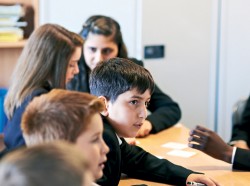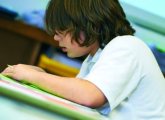Have you ever walked down the street in one of our major cities and been amazed at the number of languages you hear? Britain is a truly multi-cultural society and our linguistic map is expanding. More than 300 languages are spoken in London alone, and recent news highlighted a primary school in Birmingham where 31 different languages were spoken, with the most common first language being Urdu.
These numerous languages are often referred to as ‘community languages’, spoken by members of minority groups or communities within a majority language context. For instance, Urdu is defined as a community language within the UK where English is the official and majority language.

Breaking barriers
Data published by the DfE this year shows that the number of youngsters who speak a first language other than English is around one in eight (12.9 per cent), or 417,765 pupils, and schools are becoming increasingly diverse. For example, in the east London borough of Tower Hamlets, nine of its 15 secondary schools teach at least 70 per cent of pupils whose first language is not English.
When looking at these statistics, it appears there should be a logical move to studying these community languages in secondary education. Yet schools must be aware that for many secondary school students, it may be felt there is a ‘hierarchy’ of languages where European languages have traditionally been the focus of courses at GCSE. In recent years, there has been a shift towards introducing Mandarin and Arabic, recognised for their status in a global economy, yet community languages such as Urdu and Bengali hold great potential. An advocate for community languages, the National Centre for Languages’ (CILT) recent report, ‘Positively plurilingual’ highlights their contribution to UK education, economy and society. The report claims that by improving our linguistic capacity in community languages, we can help break down cultural barriers and draw on students’ diverse cultural backgrounds to enrich the learning for all students across the curriculum.
Acknowledging and strengthening these existing language skills is paramount in fostering social harmony among different groups and can improve communication skills, which are also important in later life. Ofsted has in fact stated that ‘community languages’ should have the same status as French, German and Spanish in schools. Schools seem to be responding – with, for example, CILT research finding an increase to more than 10 per cent of secondary schools offering Urdu.
Bringing it in

Successful provision for community language learning requires all members of staff and the management team to strive to create an environment where teachers and students recognise and celebrate cultural and linguistic diversity. Pupils born in the UK and recent arrivals to the UK may need encouragement to study their mother tongue and may feel uncomfortable or embarrassed when using it at school.
Increasingly, schools with significant numbers of students from one or two ethnic minority groups include one or more community languages in their mainstream curriculum. In most cases, only students with some prior knowledge opt for these courses, yet all students can benefit from them. Research by Jim Cummins from the Ontario Institute for Studies in Education shows that bilingual children perform better in school when the school effectively teaches their mother tongue. This also gives the chance for non-speakers to open their eyes to a new language experience.
Even if your school does not include a community language on its curriculum, there are a number of options available to still support this education. More and more schools are running extra-curricular clubs at lunchtime or after school. By encouraging fun and collaborative learning, children are likely to be engaged in the subject matter, and willing to learn more.
Natural resources
When introducing a community language to students, think carefully about how you learn something new – is it seeing, hearing, or getting to practise it? For many children, it will be harder to practise a community language effectively outside of school, but using digital resources, teaching and learning can combine visual, auditory and kinaesthetic methods to make the language more accessible.
Consider bringing in textual resources such as foreign language music, video and text to bring the lessons to life. Internet and voIP technology is also a growing favourite in classrooms as it allows direct interaction with native community language speakers or via pre-recorded narratives. This is vital for improving listening as well as spoken skills. Online resources give students a way to tap into these multi-sensory learning styles to practise their vocabulary, grammar and pronunciation skills at school and at home, extending learning and allowing students to progress at their individual pace.
Innovative and stimulating ICT can make language learning faster, easier and more engaging. With community languages increasingly present in schools, it’s possible your classroom may already have speakers whose understanding and ability can benefit the whole class. This provides a valuable opportunity for collaborative learning amongst students – why not consider a ‘polyglots’ club? Create your own mini school ‘community’ where students from different linguistic backgrounds can enjoy practical and creative activities and share with others in a supportive environment their knowledge, skills and perspectives of different countries, cultures and religions.
With the growing presence of a range of community languages throughout society, and their benefits for building a stronger society, it is welcoming to see more young people being given the chance to explore, experience and learn languages in schools that will continue to help break down international and domestic communication barriers.
Urdu in the classroom – A Teacher’s View
Sheraz Ali, MA Urdu, is a teacher and currently Urdu tutor at the University of Manchester and University of Leeds
“Languages are part of the cultural wealth of our society, and are where our past, present and future co-exist. According to a CILT survey, Urdu is one of the most widely used community languages in England. The relationship between Urdu and Britain is not new; it started around 350 years ago when the British entered into the subcontinent as a trader and established the East India Company. Britain studied in depth the culture, linguistic, social and economic background of the sub-continent and they realised to obtain full political power they needed to learn the language. Even Queen Victoria hired an Indian Muslim to teach her Urdu.
In my view as an educator, a class is successful if the material covered is relevant, meaningful, and can be applied to student’s lives. I look for ways to get students connected to the material, using creative methods to illustrate main points and to keep the learning process dynamic and fun. Technology can be a great tool for this, and I integrate this frequently, for example by assigning projects where GCSE students use video and web-based skills and resources to demonstrate their understanding of key concepts in Urdu. Urdu films, rhymes and songs can also be seen and heard in my classes, to reinforce the structure and idiomatic expressions that are being taught.
By encouraging Urdu education, and discovering other cultures, countries, communities, it also gives the learner valuable insight into his or her own culture and society.”
About the expert
Justin Sycamore is the founder of Vocab Express, an online, constantly updated vocabulary learning application for schools and individuals that since 2009, has been dedicated to bringing the best of online learning to the world of foreign languages. For more information, visit vocabexpress.com










